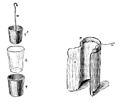File:PSM V09 D361 Static electricity experiment.jpg

Original file (1,346 × 1,175 pixels, file size: 135 KB, MIME type: image/jpeg)
Captions
Captions
| DescriptionPSM V09 D361 Static electricity experiment.jpg |
English: Drawing (left) showing a dissectible Leyden jar. A Leyden jar, the first form of capacitor, was an antique electrical device that stored static electricity. This disassemblable version, Invented by American statesman and scientist Benjamin Franklin, was used during the 19th century to demonstrate the erroneous theory that the electric charge in a Leyden jar was stored in its glass dielectric, not on the metal plates. The assembled jar was first charged with electricity. When it was disassembled, the pieces could be handled and were found to be uncharged. However, when it was reassembled, a large spark could still be obtained from the jar. This was supposed to show that the electric charge was inside the glass. However, it was later shown that this was a special effect due to charge transferred to the glass by corona discharge when the jar was disassembled. Leyden jars, like other capacitors, store their charge on their metal plates. |
|||||
| Date | ||||||
| Source | Popular Science Monthly Volume 9 | |||||
| Author | Unknown authorUnknown author | |||||
| Permission (Reusing this file) |
|
|||||
File history
Click on a date/time to view the file as it appeared at that time.
| Date/Time | Thumbnail | Dimensions | User | Comment | |
|---|---|---|---|---|---|
| current | 20:34, 14 July 2010 |  | 1,346 × 1,175 (135 KB) | Ineuw (talk | contribs) | {{Information |Description = Static electricity experiment |Source = http://en.wikisource.org/wiki/Page:Popular_Science_Monthly_Volume_9.djvu/361 |Date = 1876 |Author = Unknown |Permission = {{PD-old}} |other_versions = }} {{GFDL-user-w|en|Wikisour |
You cannot overwrite this file.
File usage on Commons
There are no pages that use this file.
File usage on other wikis
The following other wikis use this file:
Metadata
This file contains additional information such as Exif metadata which may have been added by the digital camera, scanner, or software program used to create or digitize it. If the file has been modified from its original state, some details such as the timestamp may not fully reflect those of the original file. The timestamp is only as accurate as the clock in the camera, and it may be completely wrong.
| _error | 0 |
|---|